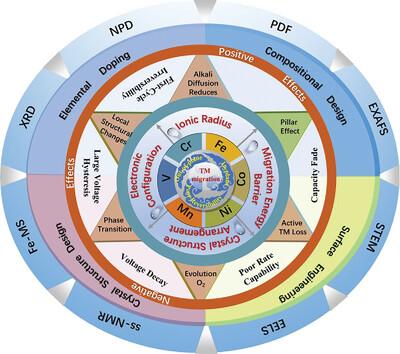揭示三维过渡金属(Ni, Co, Mn, Fe, Cr, V)离子在层状氧化物阴极中的迁移:一条通向优质锂离子和钠离子电池阴极的途径
IF 26.8
1区 材料科学
Q1 CHEMISTRY, MULTIDISCIPLINARY
引用次数: 0
摘要
锂离子和钠离子电池是为电动汽车和电网供电的有前途的系统。层状三维过渡金属氧化物AxTMO2 (A = Li, Na;TM =三维过渡金属;0 & lt;X≤2)由于其特殊的能量密度而作为正极材料引起了广泛的关注。然而,由于与TM离子迁移相关的晶体结构退化,它们面临着一些技术挑战,如循环稳定性差,速率能力差,电压滞后明显,电压衰减严重。为了应对这些挑战,本文对TM离子在AxTMO2中的迁移行为进行了深入的讨论和全面的了解。首先,讨论了影响TM离子迁移的关键热力学和动力学,包括离子半径、电子构型、晶体结构排列和迁移能垒。特别是,详细介绍了Ni, Co, Mn, Fe, Cr和V离子在层状阴极材料中的普遍和特定迁移特性。随后,从技术问题背后的基础科学角度强调了这些迁移对电化学性能的影响,并总结了调制TM离子迁移以开发先进阴极材料的策略。此外,研究TM离子迁移的表征技术,如中子衍射(ND)、扫描透射电子显微镜(STEM)、核磁共振(NMR)等。最后,对未来的研究方向进行了全面的总结。这一综述为锂离子和钠离子电池层状氧化物阴极材料的基本设计提供了有价值的见解。本文章由计算机程序翻译,如有差异,请以英文原文为准。

Unraveling 3d Transition Metal (Ni, Co, Mn, Fe, Cr, V) Ions Migration in Layered Oxide Cathodes: A Pathway to Superior Li‐Ion and Na‐Ion Battery Cathodes
Li‐ion and Na‐ion batteries are promising systems for powering electric vehicles and grid storage. Layered 3d transition metal oxides Ax TMO2 (A = Li, Na; TM = 3d transition metals; 0 < x ≤ 2) have drawn extensive attention as cathode materials due to their exceptional energy densities. However, they suffer from several technical challenges caused by crystal structure degradation associated with TM ions migration, such as poor cycling stability, inferior rate capability, significant voltage hysteresis, and serious voltage decay. Aiming to tackle these challenges, this review provides an in‐depth discussion and comprehensive understanding of the TM ions migration behaviors in Ax TMO2 . First, the key thermodynamics and kinetics that impact TM ions migration are discussed, covering ionic radius, electronic configuration, crystal structure arrangement, and migration energy barrier. In particular, details are provided regarding the universal and specific migration characteristics of Ni, Co, Mn, Fe, Cr, and V ions in layered cathode materials. Subsequently, the impacts of these migrations on electrochemical performance are emphasized in terms of the fundamental science behind technical issues, and strategies to modulate TM ions migration for advanced cathode materials development are summarized. Besides, characterization techniques for probing the TM ions migration are present, like neutron diffraction (ND), scanning transmission electron microscopy (STEM), nuclear magnetic resonance (NMR), and others. Finally, future directions in this regard are comprehensively concluded. This review offers valuable insights into the basic design of advanced layered oxide cathode materials for Li‐ion and Na‐ion batteries.
求助全文
通过发布文献求助,成功后即可免费获取论文全文。
去求助
来源期刊

Advanced Materials
工程技术-材料科学:综合
CiteScore
43.00
自引率
4.10%
发文量
2182
审稿时长
2 months
期刊介绍:
Advanced Materials, one of the world's most prestigious journals and the foundation of the Advanced portfolio, is the home of choice for best-in-class materials science for more than 30 years. Following this fast-growing and interdisciplinary field, we are considering and publishing the most important discoveries on any and all materials from materials scientists, chemists, physicists, engineers as well as health and life scientists and bringing you the latest results and trends in modern materials-related research every week.
 求助内容:
求助内容: 应助结果提醒方式:
应助结果提醒方式:


